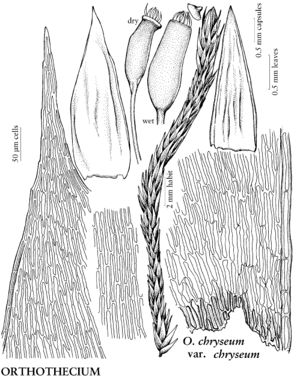Difference between revisions of "Orthothecium chryseum"
in P. Bruch and W. P. Schimper, Bryol. Europ. 5: 107. 1851.
FNA>Volume Importer |
imported>Volume Importer |
||
| Line 65: | Line 65: | ||
|publication year=1851 | |publication year=1851 | ||
|special status=Illustrated | |special status=Illustrated | ||
| − | |source xml=https:// | + | |source xml=https://bibilujan@bitbucket.org/aafc-mbb/fna-data-curation.git/src/bb6b7e3a7de7d3b7888a1ad48c7fd8f5c722d8d6/coarse_grained_fna_xml/V28/V28_863.xml |
|genus=Orthothecium | |genus=Orthothecium | ||
|species=Orthothecium chryseum | |species=Orthothecium chryseum | ||
Revision as of 22:49, 27 May 2020
Plants large, in tufts, golden. Stems 5–10 cm, 3 mm wide, erect or ascending, simple or sparingly branched. Leaves imbricate, ovate-lanceolate to ovate-triangular, strongly plicate, 1–5 mm; base slightly decurrent; margins partially recurved, entire; apex short-acuminate; ecostate or costa double, very short; basal laminal cells shorter, broader than medial cells, golden brown; medial cells linear, 84 × 6 µm. Specialized asexual reproduction absent. Seta golden brown. Capsule frequently slightly asymmetric, 1.5–1.8 mm. Spores 14–16 µm.
Distribution

North America, n, c Europe, Asia (Russian Arctic), Atlantic Islands (Iceland).
Discussion
Varieties 5 (2 in the flora).
Orthothecium chryseum has ovate-triangular perichaetial leaves. The sporophytes are infrequent; the capsules are ovoid-cylindric and contracted below the mouth when dry and empty.
Selected References
None.
Key
| 1 | Leaves concave. | Orthothecium chryseum var. chryseum |
| 1 | Leaves cochleariform. | Orthothecium chryseum var. cochleariifolium |
